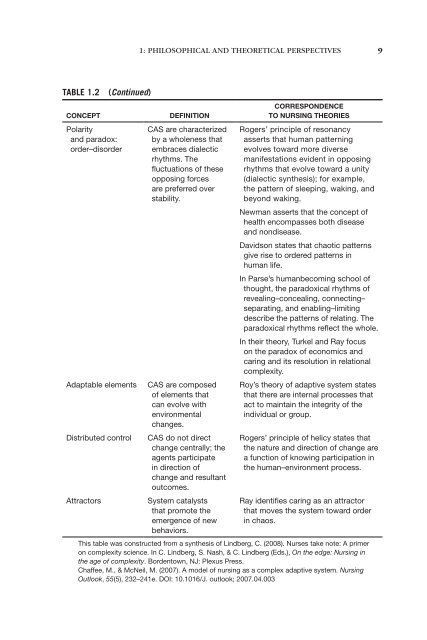Nursing, Caring, and Complexity Science: For Human ... - Axon
Nursing, Caring, and Complexity Science: For Human ... - Axon
Nursing, Caring, and Complexity Science: For Human ... - Axon
Create successful ePaper yourself
Turn your PDF publications into a flip-book with our unique Google optimized e-Paper software.
1: Philosophical <strong>and</strong> Theoretical Perspectives 9<br />
Table 1.2 (Continued)<br />
Concept<br />
Polarity<br />
<strong>and</strong> paradox:<br />
order–disorder<br />
Adaptable elements<br />
Distributed control<br />
Attractors<br />
Definition<br />
CAS are characterized<br />
by a wholeness that<br />
embraces dialectic<br />
rhythms. The<br />
fluctuations of these<br />
opposing forces<br />
are preferred over<br />
stability.<br />
CAS are composed<br />
of elements that<br />
can evolve with<br />
environmental<br />
changes.<br />
CAS do not direct<br />
change centrally; the<br />
agents participate<br />
in direction of<br />
change <strong>and</strong> resultant<br />
outcomes.<br />
System catalysts<br />
that promote the<br />
emergence of new<br />
behaviors.<br />
Correspondence<br />
to <strong>Nursing</strong> Theories<br />
Rogers’ principle of resonancy<br />
asserts that human patterning<br />
evolves toward more diverse<br />
manifestations evident in opposing<br />
rhythms that evolve toward a unity<br />
(dialectic synthesis); for example,<br />
the pattern of sleeping, waking, <strong>and</strong><br />
beyond waking.<br />
Newman asserts that the concept of<br />
health encompasses both disease<br />
<strong>and</strong> nondisease.<br />
Davidson states that chaotic patterns<br />
give rise to ordered patterns in<br />
human life.<br />
In Parse’s humanbecoming school of<br />
thought, the paradoxical rhythms of<br />
revealing–concealing, connecting–<br />
separating, <strong>and</strong> enabling–limiting<br />
describe the patterns of relating. The<br />
paradoxical rhythms reflect the whole.<br />
In their theory, Turkel <strong>and</strong> Ray focus<br />
on the paradox of economics <strong>and</strong><br />
caring <strong>and</strong> its resolution in relational<br />
complexity.<br />
Roy’s theory of adaptive system states<br />
that there are internal processes that<br />
act to maintain the integrity of the<br />
individual or group.<br />
Rogers’ principle of helicy states that<br />
the nature <strong>and</strong> direction of change are<br />
a function of knowing participation in<br />
the human–environment process.<br />
Ray identifies caring as an attractor<br />
that moves the system toward order<br />
in chaos.<br />
This table was constructed from a synthesis of Lindberg, C. (2008). Nurses take note: A primer<br />
on complexity science. In C. Lindberg, S. Nash, & C. Lindberg (Eds.), On the edge: <strong>Nursing</strong> in<br />
the age of complexity. Bordentown, NJ: Plexus Press.<br />
Chaffee, M., & McNeil, M. (2007). A model of nursing as a complex adaptive system. <strong>Nursing</strong><br />
Outlook, 55(5), 232–241e. DOI: 10.1016/J. outlook; 2007.04.003
















